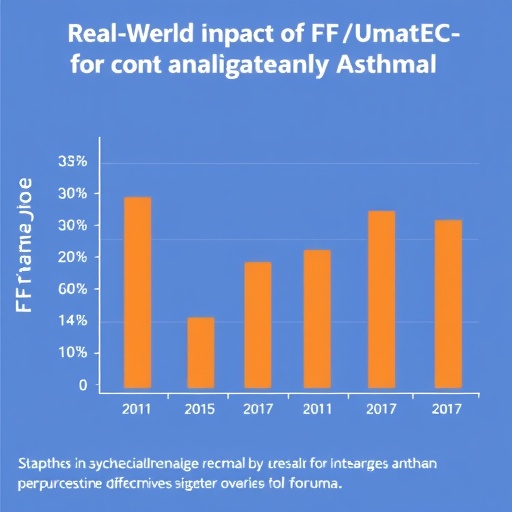In recent years, the management of asthma has seen considerable advancements, particularly with the introduction of novel combination therapies that offer patients a multifaceted approach to treatment. One such therapy that has gained prominence is the combination of Fluticasone Furoate, Umeclidinium, and Vilanterol (FF/UMEC/VI). This trio of medications leverages the benefits of a corticosteroid, a long-acting muscarinic antagonist, and a long-acting beta-agonist, aiming to deliver a comprehensive solution to asthma management. The recent post-marketing surveillance conducted in Japan shines a light on the real-world safety and effectiveness of this combination therapy.
The importance of real-world studies cannot be overstated. Randomized clinical trials, while crucial for establishing efficacy, often do not reflect the complexities of diverse patient populations and their varied responses to treatment. The purpose of the post-marketing surveillance was to gather real-world data on how FF/UMEC/VI performs among patients with asthma outside the controlled environments of clinical trials. According to the findings, patients using this triple therapy showed significant improvements in overall asthma control compared to those on previous treatments.
Asthma, a chronic inflammatory condition of the airways, affects millions worldwide, leading to symptoms that can range from mild to life-threatening. The multifactorial nature of asthma symptoms creates a pressing need for effective therapies that address both the physiological symptoms and the inflammation characteristic of the disease. Combining Fluticasone Furoate, a powerful steroid, with Umeclidinium and Vilanterol, which work as bronchodilators, creates a robust formulation aimed at tackling both the underlying causes and the symptoms of asthma.
The findings from the Japanese post-marketing surveillance, as reported by Asai et al., underscore the effectiveness of this therapy in a real-world setting, marking a significant step forward in asthma management. Patients reported improved lung function and a decrease in the frequency of asthma exacerbations, indicating that the components of FF/UMEC/VI work synergistically to provide relief. The data also highlighted a reduction in the need for rescue inhalers, an objective measure of asthma control.
Moreover, safety profiles are always a significant consideration when it comes to chronic treatments. The study reported that the combination therapy was generally well tolerated among patients, with adverse effects being mild and manageable. Monitoring the safety of inhalation therapies in a large patient cohort over time is crucial, especially considering the long-term treatment required for chronic conditions like asthma.
An equally important aspect of the study was patient satisfaction with the treatment regimen. Surveys conducted as part of the post-marketing analysis indicated that many patients preferred the convenience of a single inhaler combining all three medications. This not only simplifies the treatment regimen but also promotes adherence, which is a persistent challenge in chronic disease management. Patients who struggle with complex medication schedules are more likely to miss doses, leading to poorer health outcomes.
The engagement of healthcare providers and patients in the survey and data collection process further enriches the findings. By including patient-reported outcomes, the researchers ensured that the effectiveness of the therapy was evaluated not just through clinical metrics but also through the lens of those living with the condition. This patient-centered approach provides valuable insights into improving asthma care and treatment pathways.
As with any emerging therapy, ongoing post-marketing surveillance is essential. While initial results are promising, continuous monitoring can shed light on long-term efficacy and safety, allowing for any necessary adjustments in clinical guidelines. This ongoing vigilance will ultimately contribute to maintaining high standards of care for asthma patients and ensuring that the benefits of this combination therapy continue over time.
One of the challenges remaining in asthma management is the variability in patient response to therapies. Individual differences in genetics, lifestyle, and the presence of comorbid conditions can affect treatment outcomes. Future research directions following this surveillance could aim to identify biomarkers or clinical characteristics that predict response to FF/UMEC/VI therapy. Such personalized approaches could further refine and optimize treatment plans for asthma patients.
Furthermore, public awareness around asthma and its treatment options continues to lag behind the advancements in medical science. Many patients and healthcare practitioners may still not fully understand the mechanisms of action for combination therapies like FF/UMEC/VI. Increasing educational efforts and communication regarding the advantages of this therapy will help empower patients to engage actively in their treatment decisions.
Lastly, as the healthcare landscape continues to evolve with research driving new therapies and interventions, the role of healthcare providers remains crucial. They must stay informed about the latest findings and continue to advocate for evidence-based practices that prioritize patient outcomes. The successful integration of new therapies into routine clinical practice will ultimately depend on collaborative efforts between healthcare providers, researchers, and patients.
In conclusion, the post-marketing surveillance study in Japan has provided essential insight into the real-world efficacy and safety of the FF/UMEC/VI combination therapy for asthma patients. The findings highlight improved asthma control, patient satisfaction, and safety, paving the way for this treatment to become a cornerstone in asthma management. Ongoing monitoring and research will be vital as we strive to enhance patient care and achieve better health outcomes in the field of respiratory medicine.
Subject of Research: Real-world safety and effectiveness of Fluticasone Furoate/Umeclidinium/Vilanterol in asthma patients.
Article Title: Real-World Safety and Effectiveness of Fluticasone Furoate/Umeclidinium/Vilanterol in Patients with Asthma: Final Analysis of a Post-Marketing Surveillance in Japan.
Article References:
Asai, K., Morioka, Y., Ito, R. et al. Real-World Safety and Effectiveness of Fluticasone Furoate/Umeclidinium/Vilanterol in Patients with Asthma: Final Analysis of a Post-Marketing Surveillance in Japan. Adv Ther (2025). https://doi.org/10.1007/s12325-025-03421-2
Image Credits: AI Generated
DOI: https://doi.org/10.1007/s12325-025-03421-2
Keywords: Asthma, Fluticasone Furoate, Umeclidinium, Vilanterol, combination therapy, post-marketing surveillance, real-world effectiveness, patient safety, adherence, chronic disease management.
Tags: asthma control improvementsasthma symptom managementasthma treatment advancementschronic inflammatory airway conditioncombination therapy for asthmacorticosteroid long-acting muscarinic antagonistefficacy of asthma treatmentsFF/UMEC/Vilanterol asthma therapyFluticasone Umeclidinium Vilanterol effectivenesspatient population diversity in asthmapost-marketing surveillance asthmareal-world asthma management





